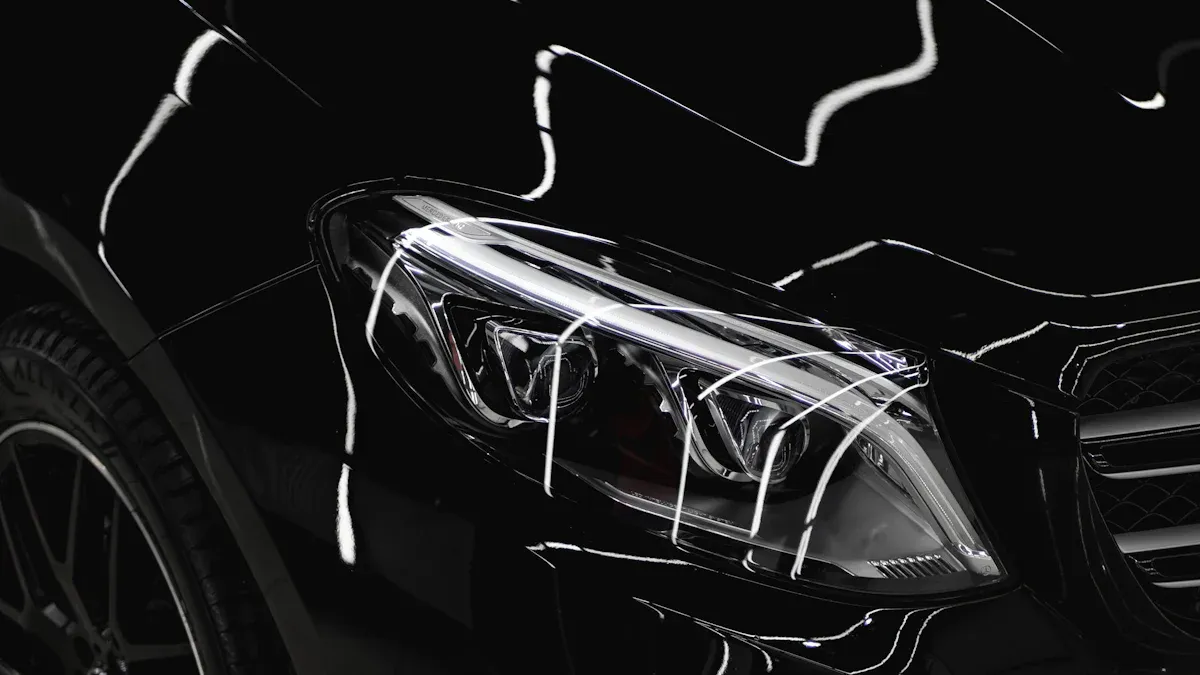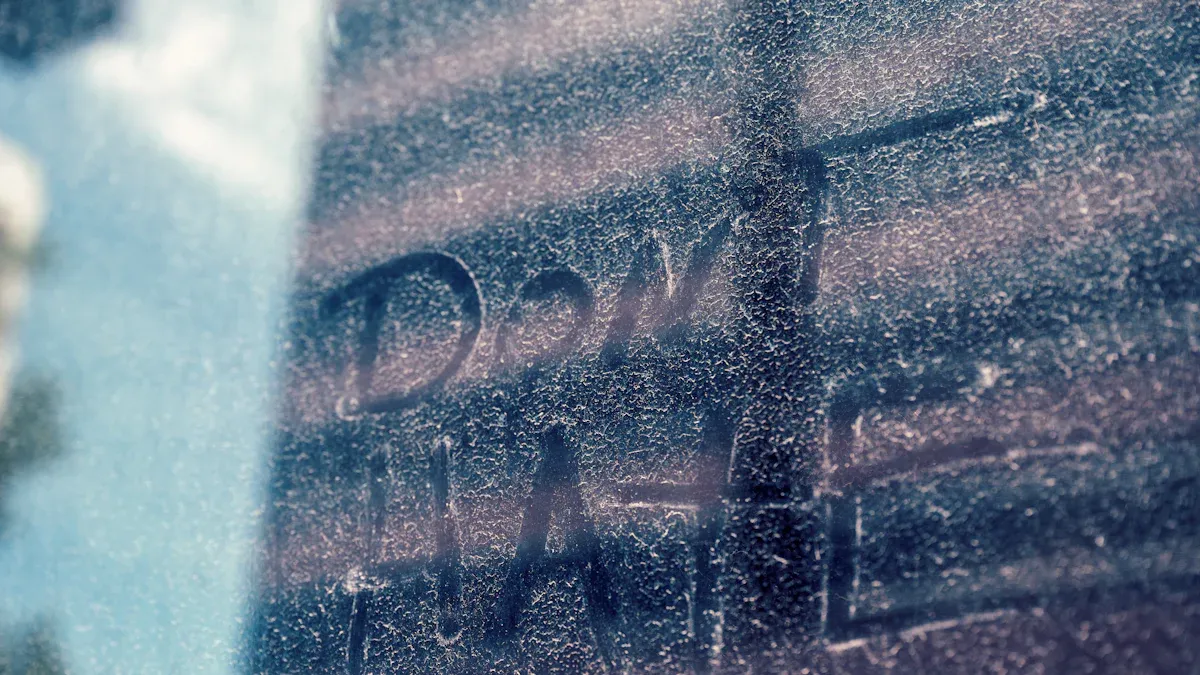
An excellent car wrap like the Best Ravoony Glossy Explosion Purple Car Vinyl Wrap , a glossy car wrap represents a significant investment in your car's style and branding. You can significantly extend your car wrap lifespan by following a few simple care principles.
Key Takeaways
- Wash your vehicle wrap often and correctly to keep it clean.
- Protect your wrap from sun damage and bad weather.
- Avoid harsh chemicals and strong water sprays to prevent damage.
Essential Washing and Cleaning Techniques

Consistent cleaning is the most effective way to protect your vehicle wrap. Proper washing removes dirt and contaminants before they can cause permanent damage. Following the right techniques will preserve the vinyl's finish and extend your car wrap lifespan.
The Right Way to Hand Wash
You should always choose hand washing over automated methods. This gentle approach gives you complete control, preventing damage to the wrap's surface and edges. For best results, especially with matte finishes, follow a specific procedure.
- Rinse First: Start by rinsing the entire vehicle with clean water. This removes loose dirt and dust, preventing scratches during the washing stage.
- Wash Gently: Use a wrap-safe soap and two buckets—one for soapy water and one for rinsing your wash mitt. Wash the vehicle from top to bottom in straight, overlapping lines. Avoid circular motions, which can create swirl marks on some finishes.
- Address Tough Spots: For stubborn spots like bug splatter or tree sap, spray the area with a dedicated cleaner. Let it sit for about 30 seconds to dissolve the contaminant.
- Dry Carefully: Use a clean, dry microfiber towel to gently pat the vehicle dry. Do not buff or polish the surface, as this can damage the vinyl.
Safe Cleaning Products and Tools
Using the right products is just as important as using the right technique. Harsh chemicals can fade colors and degrade the vinyl, while abrasive tools can cause scratches. You should stick to products designed for automotive finishes.
| Product/Tool | Description |
|---|---|
| pH-Neutral Soap | Most quality car wash soaps are safe. Meguiar’s Gold Class Car Wash is a great pH-neutral option that effectively cleans vinyl. |
| Wrap-Specific Cleaner | For matte or textured wraps, use a specialized product like Croftgate Wrap After Care JP Matte to maintain the unique finish. |
| Microfiber Mitt/Towel | Always use soft, edgeless microfiber wash mitts and drying towels. They trap dirt effectively without scratching the surface. |
In a pinch, you can use a diluted, mild dishwashing liquid. However, a dedicated car wash soap is always the superior choice for the long-term health of your wrap.
Why to Avoid Automatic Car Washes
You must avoid "brush-style" automatic car washes completely. The stiff, spinning brushes are highly abrasive. They can easily scratch, dull, and even tear your vinyl wrap. These machines can also catch the edges of the wrap and cause them to lift or peel.
Even "touchless" car washes pose a risk. They use high-pressure water jets that can be too powerful for a wrap. If aimed directly at a seam or edge, the intense pressure can force water underneath the vinyl, leading to lifting and failure of the adhesive. Protecting your investment means washing it by hand.
Handling Spills and Contaminants
You need to clean contaminants like bird droppings, bug splatter, and tree sap immediately. These substances are often acidic and can eat into the vinyl, causing permanent stains or damage if left to sit.
Follow these steps to safely remove them:
- Soften the Spot: Rinse the area with warm water to loosen the debris.
- Apply a Cleaner: Spray a wrap-safe cleaner onto a damp microfiber towel and gently apply it to the spot. Let it sit for a minute to break down the contaminant.
- Wipe Gently: Lightly wipe the area with the towel. Do not scrub or apply heavy pressure. Patience is key; reapply the cleaner if the stain persists.
- Rinse and Dry: Once the spot is gone, rinse the area thoroughly with clean water and dry it with a fresh microfiber towel.
Proactive Protection to Extend Car Wrap Lifespan
Washing your wrap is essential, but proactive protection shields it from damage before it happens. Taking steps to guard against environmental threats is a key strategy for maximizing your investment and ensuring a long car wrap lifespan.
Guarding Against Sun and UV Damage
The sun's ultraviolet (UV) rays are one of the biggest threats to your vehicle wrap. Over time, UV radiation breaks down the chemical bonds in the vinyl's color pigments and polymer chains. This process, called photodegradation, causes colors to fade and can make the material brittle and prone to cracking.
You can spot sun damage by looking for these signs:
- Colors that appear less bold or rich.
- A rough or brittle texture when you touch the wrap.
- Small cracks, tears, or peeling areas.
- Uneven fading on different parts of the vehicle.
To protect your wrap from the sun, you should adopt a few simple habits.
- Park in the shade: Use garages, carports, or even the shadow of a building whenever possible.
- Use a car cover: A breathable car cover offers excellent protection if you must park outdoors for long periods.
- Apply a UV protectant: Use a spray-on vinyl protectant designed to block UV rays.
- Wash regularly: Keeping the surface clean prevents dirt from baking into the vinyl under the sun.
Dealing with Extreme Weather
Extreme weather, especially winter conditions, requires special attention. Road salt is a major concern, as it can dry out the vinyl and cause it to become brittle if left on the surface. Although most wraps are made to resist salt, you must clean it off regularly.
Follow these precautions during freezing temperatures:
- Remove Road Salt Promptly: Wash your vehicle at least once a week during winter to prevent salt buildup, paying close attention to wheel wells and the undercarriage.
- Avoid Ice Scrapers: Never use an ice scraper or hard-bristled brush on your wrap. These tools will scratch and tear the vinyl. Use your vehicle's defroster to melt ice and a soft brush for snow.
- Use Low-Pressure Water: When washing, use a low-pressure water source. High pressure can force water under the wrap's edges and cause peeling.
Proper care in harsh weather is critical for your car wrap lifespan.
Inspecting Edges and Seams
The edges and seams are the most vulnerable areas of your vehicle wrap. This is where lifting and peeling typically begin. You should inspect these areas regularly to catch problems early.
Look for these signs of a failing seam:
- Corners and edges that are visibly lifting from the vehicle's surface.
- Seams or overlaps that you can easily see or feel.
- Jagged or uneven lines where two pieces of vinyl meet.
Pro Tip: If you find a lifting edge, you can often fix it yourself. Gently clean under the lifted vinyl with a microfiber towel wrapped around a squeegee and soaked in isopropyl alcohol. After it dries, use a heat gun on a low setting to warm the vinyl and press it back down firmly. Addressing these small issues immediately is the best way to preserve your car wrap lifespan.
Common Mistakes That Damage Your Wrap

You can easily damage your wrap by making a few common mistakes. Knowing what to avoid is just as important as knowing what to do. Proper care prevents costly repairs and preserves your vehicle's appearance.
Avoiding Abrasive Polishes and Chemicals
You should never use traditional polishes or waxes on your vehicle wrap. These products are designed to create shine, which can ruin a matte or satin finish by leaving streaks and shiny patches. Carnauba wax is especially harmful, as it can leave a residue that is difficult to remove. You must also avoid harsh chemicals that degrade the vinyl.
⚠️ Chemicals to Avoid:
- Solvents and degreasers
- Petroleum-based cleaners
- Acidic agents
- Brake fluid
The Dangers of High-Pressure Washing
You can use a pressure washer, but you must be extremely careful. High pressure can force water under the wrap's edges, causing them to lift and peel. If you choose to use one, you must follow strict safety rules.
Pressure Washer Safety Rules:
- Keep water pressure below 2000 PSI.
- Maintain a distance of at least 12 inches from the surface.
- Use a 40-degree spray nozzle.
- Never spray directly at seams or edges.
Ignoring Peeling Edges or Lifts
You must address peeling edges as soon as you spot them. A small lift can collect dirt and moisture, weakening the adhesive. Over time, this small problem can grow into a large tear that requires a professional repair. Ignoring these issues shortens your car wrap lifespan and can lead to more significant damage. While you can attempt minor DIY fixes, a professional can ensure a durable, seamless repair.
Using Improper Drying Methods
You should never let your wrap air-dry after washing. Tap water contains minerals like calcium and magnesium. When the water evaporates, it leaves these minerals behind as hard water spots. If you do not remove them quickly, these deposits can etch into the vinyl and cause permanent damage. Always use a clean, soft microfiber towel to gently pat the surface dry.
You protect your investment through diligent care. Consistent, gentle cleaning is the foundation of proper wrap maintenance. Proactive protection from sun and weather prevents long-term degradation. You preserve the vinyl for years by avoiding harsh chemicals and high-pressure washing. This careful approach maximizes your car wrap lifespan.
FAQ
How long does a vehicle wrap last?
You can expect a professionally installed wrap to last 5 to 7 years. Proper care, including regular washing and sun protection, helps you reach this lifespan.
Can you wax a vehicle wrap?
You should never apply traditional wax to your wrap. Wax damages matte finishes and can leave a hazy residue. Use a wrap-specific sealant or ceramic coating for protection instead.
What happens if the wrap gets scratched?
Minor scratches may heal with gentle heat from a heat gun. You should take deep scratches that tear the vinyl to a professional for repair to prevent further damage.


















0 Comments